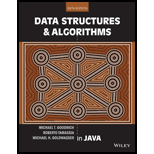
Explanation of Solution
Reimplementation of DoublyLinkedList class using only one sentinel node:
The doubly linked list is a linked data structure which contains the collection of sequentially data with two sentinel nodes such as “header” and “trailer”.
- If there is only one sentinel node, then the list is circularly linked using sentinel node.
- That is, header is sentinel node means, the next of the header is first node of list and previous node of header is last node of list.
Code for DoublyLinkedList class using only one sentinel node:
//Define the DoublyLinkedList class
public class DoublyLinkedList<E>
{
//Declare only one sentinel node
private Node<E> header;
//Declare and initialize the "size" variable
private int size = 0;
/*Define the Constructor to construct a new empty list. */
public DoublyLinkedList()
{
//Create header sentinel
header = new Node<>(null, null, null);
}
//Define the size() method
public int size()
{
/*Returns the number of elements in the linked list. */
return size;
}
//Define isEmpty() method
public boolean isEmpty()
{
//Check whether the linked list is empty
return size == 0;
}
//Define first() method
public E first()
{
//Check whether the list is empty
if(isEmpty())
//Return null
return null;
//Returns the first element of the list
return header.getNext().getElement();
}
//Define last() method
public E last( )
{
//Check whether the list is empty
if(isEmpty())
//Return null
return null;
/*Returns the last element of the list using the single sentinel node "header". */
return header.getPrev().getElement( );
}
//Define addFirst() method
public void addFirst(E e)
{
/*Call addBetween() method to adds element "e" to the front of the list. */
addBetween(e, header, header.getNext
}
/Define the addLast() method
public void addLast(E e)
{
/*Call addBetween() method to adds element e to the end of the list using single sentinel node "header". */
addBetween(e, header.getPrev(), header);
}
//Define the removeFirst() method
public E removeFirst()
{
//Check whether the list is empty
if (isEmpty())
//Return null
return null;
/*Call remove() method to removes and returns the first element of the list. */
return remove(header...
Want to see the full answer?
Check out a sample textbook solution
Chapter 3 Solutions
Data Structures and Algorithms in Java
- Please solve and answer the questions correctly please. Thank you!!arrow_forwardConsidering the TM example of binary sum ( see attached)do the step-by-step of execution for the binary numbers 1101 and 11. Feel free to use the Formal Language Editor Tool to execute it; Write it down the current state of the tape (including the head position) and indicate the current state of the TM at each step.arrow_forwardI need help on inculding additonal code where I can can do the opposite code of MatLab, where the function of t that I enter becomes the result of F(t), in other words, turning the time-domain f(t) into the frequency-domain function F(s):arrow_forward
 C++ Programming: From Problem Analysis to Program...Computer ScienceISBN:9781337102087Author:D. S. MalikPublisher:Cengage Learning
C++ Programming: From Problem Analysis to Program...Computer ScienceISBN:9781337102087Author:D. S. MalikPublisher:Cengage Learning EBK JAVA PROGRAMMINGComputer ScienceISBN:9781337671385Author:FARRELLPublisher:CENGAGE LEARNING - CONSIGNMENT
EBK JAVA PROGRAMMINGComputer ScienceISBN:9781337671385Author:FARRELLPublisher:CENGAGE LEARNING - CONSIGNMENT New Perspectives on HTML5, CSS3, and JavaScriptComputer ScienceISBN:9781305503922Author:Patrick M. CareyPublisher:Cengage Learning
New Perspectives on HTML5, CSS3, and JavaScriptComputer ScienceISBN:9781305503922Author:Patrick M. CareyPublisher:Cengage Learning Systems ArchitectureComputer ScienceISBN:9781305080195Author:Stephen D. BurdPublisher:Cengage Learning
Systems ArchitectureComputer ScienceISBN:9781305080195Author:Stephen D. BurdPublisher:Cengage Learning C++ for Engineers and ScientistsComputer ScienceISBN:9781133187844Author:Bronson, Gary J.Publisher:Course Technology Ptr
C++ for Engineers and ScientistsComputer ScienceISBN:9781133187844Author:Bronson, Gary J.Publisher:Course Technology Ptr Microsoft Visual C#Computer ScienceISBN:9781337102100Author:Joyce, Farrell.Publisher:Cengage Learning,
Microsoft Visual C#Computer ScienceISBN:9781337102100Author:Joyce, Farrell.Publisher:Cengage Learning,





